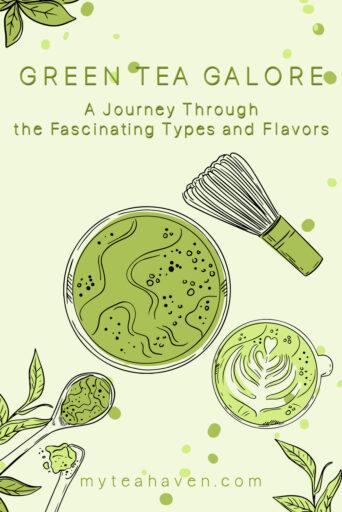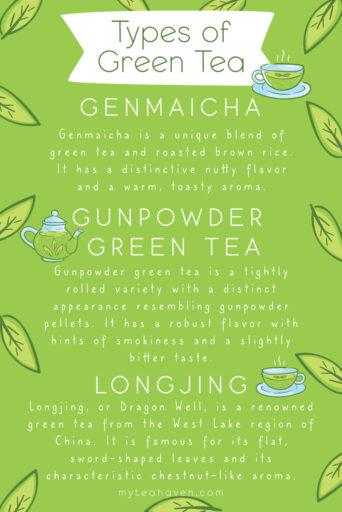Green Tea Galore: A Journey through the Fascinating Types and Flavors
Types of Green Tea
Introduction
Green tea has gained popularity worldwide for its numerous health benefits and refreshing taste. But like its black and white counterparts, there are various types of green tea with their own distinct flavors and characteristics. Today I will guide you through the different varieties of green tea, so you can expand your tea-drinking horizons and learn more about just how intricate this not quite so simple variety can be.
We are a participant in the Amazon Services LLC Associates Program, an affiliate advertising program designed to provide a means for us to earn fees by linking to Amazon.com and related sites. This post may contain affiliate links which means we may receive a commission, at no cost to you, for purchases made using our links. Please see my disclosure to learn more. Unless otherwise stated, all prices are in US$.

The Green Tea Book
The Green Tea Book has been a trusted resource for almost a decade. Now, chemist Lester A. Mitscher and health writer Victoria Dolby Toews update their ground-breaking work with the latest scientific information. The “natural medicine” in green tea is polyphenols.
What is Green Tea?

Green tea is a type of tea made from the leaves of the Camellia sinensis plant. Unlike black tea, which undergoes fermentation, green tea is minimally processed and retains more natural compounds.
This preservation of antioxidants and polyphenols contributes to the health benefits associated with green tea consumption.
Varieties of Green Tea
Green tea comes in various types, each with its own unique flavor profile and processing method. Let’s explore some popular varieties:
Sencha
Sencha is one of the most commonly consumed green teas in Japan. It has a vibrant green color and a refreshing taste.
The leaves are grown in direct sunlight, giving Sencha a grassy and slightly sweet flavor. It is a great choice for those new to green tea.
Matcha
Matcha is a powdered green tea that has gained immense popularity for its vibrant green color and ceremonial preparation.
The tea leaves are shade-grown to enhance chlorophyll production, then stone-ground into a fine powder.
Matcha has a rich, creamy taste and offers a higher concentration of antioxidants compared to other green teas.
Genmaicha
Genmaicha is a unique blend of green tea and roasted brown rice. It has a distinctive nutty flavor and a warm, toasty aroma.
The rice gives Genmaicha a slightly lower caffeine content, making it a good choice for those who are sensitive to caffeine or prefer a milder taste.
Gyokuro
Gyokuro is considered one of the highest quality green teas in Japan.
The tea leaves are shade-grown for several weeks before harvesting, resulting in a sweet and mellow flavor. Gyokuro is known for its vibrant green color, complex taste, and delicate aroma.
Hojicha
Hojicha is a roasted green tea with a reddish-brown color and a distinct smoky flavor. The tea leaves used for Hojicha are roasted at a high temperature, giving it a unique taste profile compared to other green teas.
It has lower caffeine levels and offers a smooth, toasty experience.
Jasmine Green Tea
Jasmine green tea is a fragrant blend made by infusing green tea leaves with jasmine blossoms.
The tea absorbs the floral aroma, resulting in a delicate and soothing flavor. Jasmine green tea is often enjoyed for its calming properties and aromatic experience.
Gunpowder Green Tea
Gunpowder green tea is a tightly rolled variety with a distinct appearance resembling gunpowder pellets.
It has a robust flavor with hints of smokiness and a slightly bitter taste.
The tightly rolled leaves unfurl during brewing, releasing a rich and bold infusion.
Longjing (Dragon Well)
Longjing, or Dragon Well, is a renowned green tea from the West Lake region of China.
It is famous for its flat, sword-shaped leaves and its characteristic chestnut-like aroma. Longjing tea boasts a smooth, gentle flavor with a hint of natural sweetness.
It is often treasured for its high quality and is regarded as one of China’s most celebrated teas.
Mao Feng
Mao Feng, also known as “Hairy Peak,” is a type of green tea hailing from the mountains of China.
It is characterized by its long, slender leaves with white hairs. Mao Feng tea offers a delicate and mellow flavor with a subtly sweet aroma.
Its smooth taste and refreshing qualities make it a popular choice among green tea enthusiasts.
Pi Lo Chun
Pi Lo Chun, also called “Green Snail Spring,” is a premium green tea originating from China’s Jiangsu province.
It is named after its distinctive twisted leaf shape resembling snail meat.
Pi Lo Chun is cherished for its tender leaves, vibrant green color, and unique fruity and floral notes.
Its complex flavor profile and lingering sweetness make it a prized delicacy among tea connoisseurs.
These are only a few of the many different varieties of green tea!
Popular Green Tea Blends
Green tea blends combine green tea leaves with herbs, fruits, or flowers to create unique flavor profiles. Here are a few popular green tea blends to try:
- Green Tea with Mint: The refreshing combination of green tea and mint leaves creates a cool and invigorating blend.
- Green Tea with Lemon: Adding a hint of lemon to green tea adds a citrusy tang that complements the tea’s natural flavors.
- Green Tea with Ginger: The warmth of ginger adds a spicy kick to green tea, making it a comforting and soothing blend.
- Green Tea with Peach: The sweet and fruity notes of peach enhance the delicate flavors of green tea, creating a delightful infusion.
- Green Tea with Lavender: The floral aroma of lavender pairs beautifully with green tea, providing a calming and aromatic experience.
These blends offer a twist to traditional green tea and provide an opportunity to explore different flavor combinations.

How to Choose the Right Green Tea
When selecting green tea, consider the following factors to find the perfect fit for your preferences:
Flavor Profiles of Different Types of Green Tea
Green teas vary in taste, from grassy and vegetal to nutty and floral. Experiment with different flavors to discover your preference. Sencha and Matcha are good starting points for a balanced and authentic green tea experience.
Caffeine Content
If you are sensitive to caffeine or prefer a lower caffeine intake, go for teas like Genmaicha or Hojicha, which have reduced caffeine levels. Matcha, on the other hand, offers a natural energy boost due to its higher caffeine content.
Brewing Method
Different green teas require specific brewing techniques to bring out their best flavors. Sencha is typically brewed with hot water at around 70-80°C (158-176°F), while Matcha is whisked in a bowl with a special Matcha whisk. Consider the brewing process and equipment needed for each type of green tea.
Price Range
Green teas can vary in price, depending on factors such as quality, origin, and processing method. Set a budget and explore options within your range. Remember that high-quality teas may offer a more enjoyable experience and enhanced health benefits.
Brewing Techniques for Green Tea
To fully enjoy the flavors of green tea, it’s essential to follow proper brewing techniques. Here are some general guidelines:
- Heat water to the appropriate temperature according to the type of green tea you are brewing.
- Measure the tea leaves according to the desired strength. Use around 1 teaspoon of leaves per 8 ounces of water.
- Steep the leaves for 1-3 minutes, depending on the tea variety and personal preference.
- Experiment with steeping times to find the balance of flavors that suits your taste.
- Enjoy your green tea plain or with a touch of honey or lemon, if desired.

Teabloom Perfect Measure Loose Leaf Tea Spoon
Tea scoop for black tea, green tea, oolong tea, white tea, chai tea, herbal tea, and spices. It’s the perfect size for steeping the perfect cup: 1.5 tsp portion – scoops up even larger tea leaves with ease.
A Few Final Thoughts
Green tea is a versatile and beneficial beverage that comes in various types, each with its own distinctive qualities. Whether you prefer the grassy notes of Sencha, the creamy richness of Matcha, or the nutty flavor of Genmaicha, there is a green tea variety to suit every taste.
Remember to consider factors like flavor profiles, caffeine content, brewing techniques, and price range when choosing your green tea. Explore different blends and brewing methods to discover your personal favorites. Enjoy the journey of discovering the world of green tea and its delightful flavors!

A Beginner’s Guide to Japanese Tea
Selecting and Brewing the Perfect Cup of Sencha, Matcha, and Other Japanese Teas
Japanese tea expert Per Oscar Brekell is one of the few foreigners to complete the difficult training in Japan as a tea instructor. Now, with this book, he shares the secrets and insights he’s gleaned from a career dedicated to promoting and preparing this ancient beverage.
Some Questions You Might Have
- Can I add milk to green tea?
While it’s common to add milk to black tea, it is generally not recommended to add milk to green tea. Green tea has a delicate flavor profile that may be overwhelmed by the addition of milk. That being said, you can experiment and find what suits your taste preferences.
- How should I store green tea to maintain its freshness?
To maintain the freshness of green tea, store it in an airtight container away from light, heat, and moisture. Avoid storing it near spices or strong odors, as green tea easily absorbs odors. Refrigeration is not necessary, but a cool, dark cupboard is ideal.
- Can I reuse green tea leaves?
While green tea leaves can be reused, the subsequent infusions will have a milder flavor compared to the first one. Experiment with the number of infusions based on personal preference, but generally, green tea leaves can be steeped multiple times.
- Does green tea have any side effects?
Green tea is generally safe for most people when consumed in moderate amounts. However, excessive consumption of green tea or high doses of green tea extracts may lead to side effects such as digestive issues, caffeine sensitivity, or interference with certain medications. It’s always advisable to consult with a healthcare professional if you have any concerns.
- Can green tea help with weight loss?
Green tea has been associated with weight management due to its potential to increase metabolism and fat oxidation. However, it’s important to note that green tea alone is not a magic solution for weight loss. It can be a part of a healthy lifestyle that includes a balanced diet and regular exercise.















